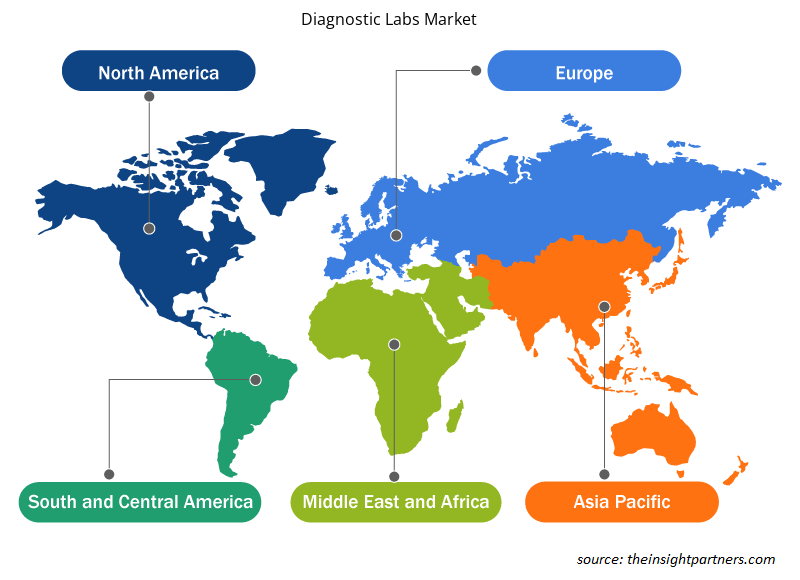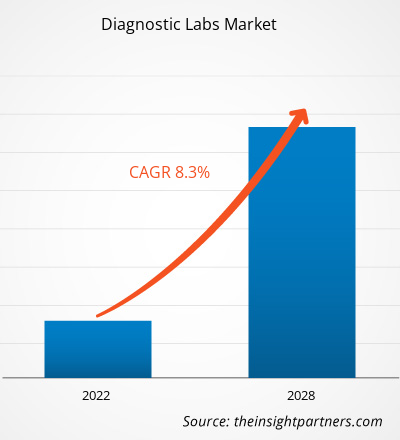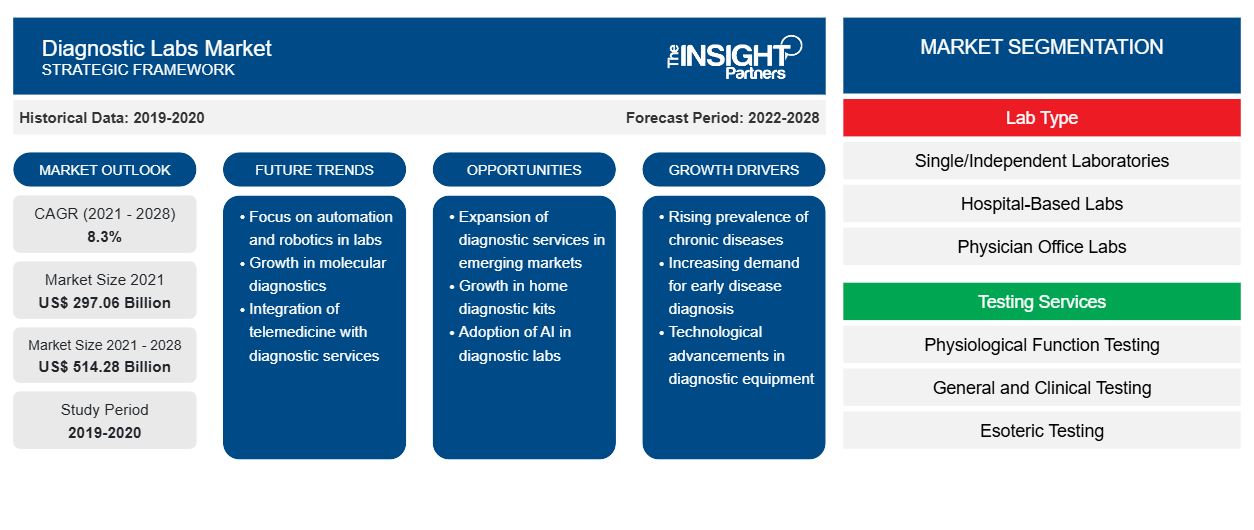[Rapport de recherche] Le marché des laboratoires de diagnostic devrait passer de 297,06 milliards de dollars américains en 2021 à 514,28 milliards de dollars américains en 2028 ; il devrait croître à un TCAC de 8,3 % de 2022 à 2028.CAGR of 8.3% from 2022 to 2028.
La prévalence croissante des maladies chroniques, l'utilisation croissante des diagnostics au point de service et l'augmentation des dépenses de santé stimulent la croissance du marché des laboratoires de diagnostic. En outre, les développements croissants dans les laboratoires de diagnostic devraient émerger comme une tendance future importante sur le marché des laboratoires de diagnostic de 2022 à 2028. Cependant, une pénurie de professionnels qualifiés freine la croissance globale du marché.
L’ère de la technologie de la santé a donc pris son envol et a transformé le secteur de la santé à des niveaux inimaginables. Depuis lors, diverses start-ups ont émergé et ont révolutionné le secteur avec des innovations telles que la télémédecine, la téléconsultation et, en particulier, les solutions de diagnostic. Les laboratoires de diagnostic constituent l’épine dorsale des soins de santé. L’adoption de la technologie est essentielle pour répondre à la demande croissante des consommateurs et avoir un avantage concurrentiel sur le marché. Dans ce contexte, les acteurs de l’industrie exploitent la puissance de la technologie pour proposer des solutions de santé de nouvelle génération. La technologie utilisée dans les laboratoires de diagnostic évolue rapidement vers une transformation complète grâce aux derniers développements en matière d’intelligence artificielle (IA) et d’apprentissage automatique (ML). Du développement de solutions de diagnostic précises et efficaces à l’adaptation aux interventions technologiques, diverses équipes de R&D avant-gardistes travaillent déjà au développement de méthodes d’analyse et de diagnostic sanguins plus récentes et plus simples. Voici quelques-uns des développements sur le marché des laboratoires de diagnostic :telemedicine, teleconsultation, and, in particular, diagnostic solutions. Diagnostics labs form the backbone of healthcare. Technology adoption is essential to meet the increasing consumer demand and have a competitive advantage in the market. In light of this, industry players are harnessing the power of technology to offer new generation healthcare solutions. The technology used in diagnostic labs is rapidly moving toward complete transformation with the help of the latest developments in artificial intelligence (AI) and machine learning (ML). From developing accurate and efficient diagnostic solutions to adapting to technological interventions, various forward-thinking R&D teams are already working to develop newer and simpler blood analysis and diagnosis methods. Some of the developments in the diagnostics lab market are as follows:
- En janvier 2019, Roche a lancé les solutions intégrées Cobas pro dans tous les pays acceptant le marquage CE. Le produit a redéfini les normes de maintenance, d'efficacité et de fiabilité en augmentant la satisfaction des patients et en réduisant le coût des prestations de soins de santé.
- En février 2020, Ortho Clinical Diagnostics a lancé un système de chimie clinique qui complète sa gamme intégrée Vitros XT, conçue pour couvrir la plupart des tests de laboratoire courants. La société a estimé son débit maximal à 755 tests par heure avec des lames à test unique et à 1 130 tests par heure avec des lames à double test. De plus, le système XT 3400 de la société a reçu le marquage CE et est disponible aux États-Unis, au Canada, en Europe, en Inde, au Japon et dans quelques pays du Moyen-Orient et d'Afrique.Ortho Clinical Diagnostics launched a clinical chemistry system that completed its integrated Vitros XT line, designed to cover most typical lab tests. The company estimated its maximum throughput at 755 tests per hour with single-test slides and 1,130 tests per hour with dual-test slides. Moreover, The company’s XT 3400 system received CE marking and is available in the US, Canada, Europe, India, Japan, and a few countries in the Middle East & Africa.
- En septembre 2021, Ortho Clinical Diagnostics a annoncé la disponibilité de l'Immediate Spin Crossmatch (ISXM) sur les analyseurs Ortho Vision et Ortho Vision Max de la société pour aider à identifier les incompatibilités receveur-donneur dans les transfusions sanguines.
Par conséquent, de tels développements devraient stimuler le marché des laboratoires de diagnostic à court terme.
Personnalisez ce rapport en fonction de vos besoins
Vous bénéficierez d'une personnalisation gratuite de n'importe quel rapport, y compris de certaines parties de ce rapport, d'une analyse au niveau des pays, d'un pack de données Excel, ainsi que de superbes offres et réductions pour les start-ups et les universités.
- Obtenez les principales tendances clés du marché de ce rapport.Cet échantillon GRATUIT comprendra une analyse de données, allant des tendances du marché aux estimations et prévisions.
L'Amérique du Nord devrait continuer à dominer le marché des laboratoires de diagnostic au cours de la période 2022-2028. La région devrait connaître une demande substantielle de laboratoires de diagnostic au cours de la période de prévision, en raison de l'adoption croissante des avancées technologiques et de l'augmentation des activités de recherche et développement dans cette région. L'amélioration des infrastructures de soins de santé et des politiques de remboursement appropriées soutiennent également le marché nord-américain des laboratoires de diagnostic. Les États-Unis devraient détenir la plus grande part de marché sur le marché nord-américain de 2022 à 2028. Le marché devrait croître dans les années à venir en raison de l'adoption croissante des avancées technologiques et de l'importance croissante accordée à l'amélioration des résultats des traitements. Les laboratoires de diagnostic américains servent de base au diagnostic précoce, à la prévention et aux soins personnalisés de millions de patients, accélérant la demande à grande échelle. Par exemple, le diagnostic précoce, la prévention et les soins personnalisés dans les laboratoires de diagnostic aux États-Unis impliquent des analyses sanguines de routine des patients et des diagnostics génétiques et moléculaires révolutionnaires. Les laboratoires de diagnostic jouent un rôle essentiel dans l'amélioration des résultats des patients et de la qualité de vie en offrant une meilleure valeur aux soins de santé du système de santé, selon le rapport de l'American Clinical Laboratory Association (ACLA). De plus, les services de laboratoire de diagnostic ne représentent que 2,3 % des dépenses de santé aux États-Unis et 2 % des dépenses de Medicare. Par conséquent, les laboratoires de diagnostic font partie intégrante du système de santé américain et du patient qu'il dessert. De plus, près de 25 % des indicateurs de qualité des soins aux patients américains pour les adultes sont inclus dans les tests de laboratoire. Les indicateurs de qualité sont des mesures standardisées et fondées sur des preuves de la qualité des soins de santé qui peuvent être facilement utilisées par les hôpitaux fournissant des données administratives aux patients hospitalisés pour suivre et mesurer les performances et les résultats cliniques. Ces indicateurs de qualité jouent un rôle essentiel pour garantir des soins cliniques de haute qualité et rentables en informant les professionnels de la médecine de laboratoire pour obtenir des données scientifiques objectives et fournir une interprétation des résultats des adultes américains. Les facteurs mentionnés ci-dessus stimulent la croissance du marché des laboratoires de diagnostic.
Informations sur les sources de revenus
En fonction de la source de revenus, le marché des laboratoires de diagnostic est segmenté en opérateurs et assureurs de régimes de soins de santé, paiements directs et système public. Le segment des opérateurs et assureurs de régimes de soins de santé devrait représenter la plus grande part de marché au cours de la période 2022-2028. Le nombre d'assureurs privés proposant des produits d'assurance personnalisables a augmenté. De nombreuses dispositions prévues par le gouvernement mondial sont similaires à la loi sur les soins abordables, qui vise à étendre la couverture d'assurance maladie. Elle incite les employeurs à fournir une couverture maladie et oblige les personnes qui ne sont pas couvertes par le programme d'assurance de leur gouvernement ou de leur employeur à souscrire une assurance maladie privée. En 2018, environ 23 % des entreprises mondiales disposaient d'une assurance médicale/hospitalière privée et environ 9,6 % d'une assurance dentaire. De plus, environ 70 % des bénéficiaires, qui bénéficient d'une assurance maladie, reçoivent leur assurance maladie privée en tant qu'avantage social. Les opérateurs de régimes de santé privés proposent des services de santé par l'intermédiaire d'établissements ou d'organismes de santé agréés. Ils peuvent également rembourser les personnes inscrites pour les services de santé achetés. Les facteurs susmentionnés contribueront à stimuler le segment des opérateurs de régimes de soins de santé et des assureurs au cours de la période de prévision.customizable insurance products. Many of the provisions provided by the Global Government are similar to the Affordable Care Act, which focuses on expanding healthcare insurance coverage. It generates incentives for employers to provide health coverage and compels people who are not covered under the insurance program of their governments or employers to purchase private healthcare insurance. In 2018, ~23% of Global had private medical/hospital insurance, and ~9.6% had dental insurance. Moreover, ~70% of beneficiaries, who receive health insurance facilities, receive their private health insurance as an employment benefit. Private health plan operators offer healthcare services through facilities or accredited healthcare organizations. Alternatively, they can reimburse enrollees for purchased health care services. The aforementioned factors will help boost the healthcare plan operators and insurers segment in the forecast period.
Les entreprises opérant sur le marché des laboratoires de diagnostic adoptent la stratégie d'innovation produit pour répondre aux demandes évolutives des clients dans le monde entier, leur permettant de maintenir leur nom de marque sur le marché mondial des laboratoires de diagnostic.
Aperçu régional du marché des laboratoires de diagnostic
Les tendances régionales et les facteurs influençant le marché des laboratoires de diagnostic tout au long de la période de prévision ont été expliqués en détail par les analystes d’Insight Partners. Cette section traite également des segments et de la géographie du marché des laboratoires de diagnostic en Amérique du Nord, en Europe, en Asie-Pacifique, au Moyen-Orient et en Afrique, ainsi qu’en Amérique du Sud et en Amérique centrale.

- Obtenez les données régionales spécifiques au marché des laboratoires de diagnostic
Portée du rapport sur le marché des laboratoires de diagnostic
| Attribut de rapport | Détails |
|---|---|
| Taille du marché en 2021 | 297,06 milliards de dollars américains |
| Taille du marché d'ici 2028 | 514,28 milliards de dollars américains |
| Taux de croissance annuel moyen mondial (2021-2028) | 8,3% |
| Données historiques | 2019-2020 |
| Période de prévision | 2022-2028 |
| Segments couverts | Par type de laboratoire
|
| Régions et pays couverts | Amérique du Nord
|
| Leaders du marché et profils d'entreprises clés |
|
Densité des acteurs du marché des laboratoires de diagnostic : comprendre son impact sur la dynamique commerciale
Le marché des laboratoires de diagnostic connaît une croissance rapide, tirée par la demande croissante des utilisateurs finaux en raison de facteurs tels que l'évolution des préférences des consommateurs, les avancées technologiques et une plus grande sensibilisation aux avantages du produit. À mesure que la demande augmente, les entreprises élargissent leurs offres, innovent pour répondre aux besoins des consommateurs et capitalisent sur les tendances émergentes, ce qui alimente davantage la croissance du marché.
La densité des acteurs du marché fait référence à la répartition des entreprises ou des sociétés opérant sur un marché ou un secteur particulier. Elle indique le nombre de concurrents (acteurs du marché) présents sur un marché donné par rapport à sa taille ou à sa valeur marchande totale.
Les principales entreprises opérant sur le marché des laboratoires de diagnostic sont :
- Quest Diagnostics Incorporated
- Eurofins Scientifique
- Holdings de la société de laboratoire d'Amérique
- Laboratoires Exact Sciences LLC
- SYNLAB International GmbH
Avis de non-responsabilité : les sociétés répertoriées ci-dessus ne sont pas classées dans un ordre particulier.

- Obtenez un aperçu des principaux acteurs du marché des laboratoires de diagnostic
Marché des laboratoires de diagnostic – Segmentation
Français En fonction du type de laboratoire, le marché des laboratoires de diagnostic est segmenté en laboratoires uniques/indépendants, laboratoires hospitaliers, laboratoires de cabinets médicaux et autres. En fonction des services de test, le marché des laboratoires de diagnostic est segmenté en tests de fonction physiologique, tests généraux et cliniques, tests ésotériques , tests spécialisés, tests prénatals non invasifs , tests COVID-19 et autres. Par source de revenus, le marché des laboratoires de diagnostic est segmenté en opérateurs de régimes de soins de santé et assureurs, paiements directs et système public. En fonction de la géographie, le marché des laboratoires de diagnostic est principalement segmenté en Amérique du Nord, Europe, Asie-Pacifique, Moyen-Orient et Afrique (MEA) et Amérique du Sud et centrale. Le marché en Amérique du Nord est en outre segmenté en États-Unis, Canada et Mexique. Le marché européen des laboratoires de diagnostic est sous-segmenté en France, Allemagne, Royaume-Uni, Espagne, Italie et reste de l'Europe. Le marché de l'Asie-Pacifique est sous-segmenté en Chine, Inde, Japon, Australie, Corée du Sud et reste de l'Asie-Pacifique. Le marché des laboratoires de diagnostic au Moyen-Orient et en Afrique est lui aussi segmenté en Arabie saoudite, aux Émirats arabes unis, en Afrique du Sud et dans le reste du Moyen-Orient et de l'Afrique. Le marché des laboratoires de diagnostic en Amérique du Sud et en Amérique centrale est segmenté en Brésil, en Argentine et dans le reste de l'Amérique du Sud et en Amérique centrale.
Profils d'entreprise
- Quest Diagnostics Incorporated
- Eurofins Scientifique
- Holdings de la société de laboratoire d'Amérique
- Laboratoires Exact Sciences LLC
- SYNLAB International GmbH
- Sonic Healthcare Limitée
- Laboratoires DASA
- Diagnostic Kingmed
- Healius Limitée
- BioRéférence
- Analyse historique (2 ans), année de base, prévision (7 ans) avec TCAC
- Analyse PEST et SWOT
- Taille du marché Valeur / Volume - Mondial, Régional, Pays
- Industrie et paysage concurrentiel
- Ensemble de données Excel
Rapports récents
Témoignages
Raison d'acheter
- Prise de décision éclairée
- Compréhension de la dynamique du marché
- Analyse concurrentielle
- Connaissances clients
- Prévisions de marché
- Atténuation des risques
- Planification stratégique
- Justification des investissements
- Identification des marchés émergents
- Amélioration des stratégies marketing
- Amélioration de l'efficacité opérationnelle
- Alignement sur les tendances réglementaires





















 Obtenez un échantillon gratuit pour - Marché des laboratoires de diagnostic
Obtenez un échantillon gratuit pour - Marché des laboratoires de diagnostic